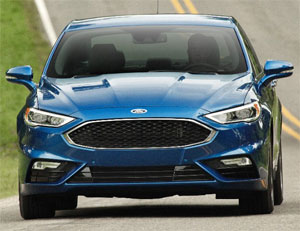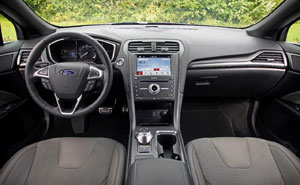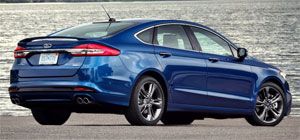2017 Ford Fusion Sport
The 2017 Ford Fusion has gone through a significant fine-tuning of late; and getting right to it, the interior control area has really been cleaned up, with a new rotary shifter, freeing up lots of space in the console.
Fusion also gains a new high end Platinum trim, boasting more luxury touches than ever before. But even better news, if you’re a fan of actually driving like we are, is the new Fusion Sport.
It adopts the Edge Sport’s twin-turbo 2.7-liter V6 EcoBoost; putting out 325-horsepower and a very beefy 380 lb-ft. of torque. A new 6-speed automatic transmission with paddle shift is included, and all-wheel-drive is standard.
Basic suspension hardware is thoroughly addressed with stiffer springs, bigger anti-roll bars, and wider 235/40 Good Year Eagle F1 tires on 19-inch dark-finished alloys. Summer-only tires are also available.
 But, it is the solenoid valve controlled continuous damping system we applaud most, a first for this segment, with pothole detection that instantly adjusts fluid flow to minimize impact. It provided a notably smoother ride than typical for an affordable four-door.
But, it is the solenoid valve controlled continuous damping system we applaud most, a first for this segment, with pothole detection that instantly adjusts fluid flow to minimize impact. It provided a notably smoother ride than typical for an affordable four-door.
When Sport mode is dialed up reaction becomes more aggressive. It also tweaks steering feel, transmission shifts, throttle response, and even exhaust note. We liked it so much we recommend leaving it in Sport mode all the time.
As for how this Fusion improves your driveway’s style; the Sport does away with the typical Fusion Aston Martin-inspired grille; and in its place is a glossy black mesh number. Just part of a whole new front fascia that has a much snarlier look.
In back there are quad exhaust outlets and of course a spoiler across the deck lid.
For you to enjoy inside, are upgraded sport seats with sueded inserts; and carbon fiber-like trim.
Our street driving impressions are quite favorable, as there is certainly less roll here than we’ve encountered in any Fusion prior to this.
And at our track test, those good vibes were confirmed; as the Fusion Sport is easily a top handler in its segment. With the exception of the Dodge Charger Hellcat, this is the American sport sedan that we’d prefer to park our butts in right now.
 But, it’s not yet a threat to German dominance. While Fusion Sport’s all-wheel-drive system is highly effective at rotating you around corners, you can really feel it working a little too much; it’s not a seamless Porsche-like system. Still, it does close the capability gap more than a little.
But, it’s not yet a threat to German dominance. While Fusion Sport’s all-wheel-drive system is highly effective at rotating you around corners, you can really feel it working a little too much; it’s not a seamless Porsche-like system. Still, it does close the capability gap more than a little.
And, the Sport is quick off the line for sure, getting us to 60 in 5.3-seconds. There’s an exhilarating amount of low end torque at launch, and it just keeps getting poured on from there.
Shifts were Jaguar-like in their speed and smoothness, and we cleared the ¼-mile in 13.9-seconds at 99 miles-per-hour.
Possibly our biggest complaint is the sound of the car. There’s plenty of it in the cabin, which is not a bad thing; it’s just a very obviously synthesized sound being pumped into the cabin.
Brakes, with an only-reasonable average stopping distance of 120-feet, are another reminder that this is still a 2-ton family car at heart.
One final update for ’17 Fusions, upgraded safety systems including autonomous braking. The system provided plenty of early warnings, but actual brake application was a little inconsistent; sometimes bringing us to a full-stop against our barrier, and sometimes not.
 Government Fuel Economy Ratings come in at 17-City, 26-Highway, and 20-Combined; so our average of 24.1 miles-per-gallon of Regular was quite good. With a fairly average Energy Impact Score of 16.5-barrels of oil use, along with 7.3-tons of CO2 emissions, annually.
Government Fuel Economy Ratings come in at 17-City, 26-Highway, and 20-Combined; so our average of 24.1 miles-per-gallon of Regular was quite good. With a fairly average Energy Impact Score of 16.5-barrels of oil use, along with 7.3-tons of CO2 emissions, annually.
Base pricing, at $34,350, is about 10-grand over a base Fusion; but it’s hardly worth comparing the two as they are really totally different cars.
We’ve recently praised a fair number of new mid-size family sedans for their improved driving competency. But the 2017 Ford Fusion Sport goes the furthest yet, without leaving affordability and practicality on the table.
Indeed, the Fusion Sport raises the performance bar for mainstream four-doors to almost European Luxury-Sport levels. That’s high praise, and why we recommend anyone still “car” shopping, to give it a very close look.
Specifications
- Engine: 2.7 liter
- Horsepower: 325
- Torque: 380 lb-ft.
- 0-60 mph: 5.3 seconds
- 1/4 mile: 13.9 seconds @ 99 mph
- EPA: 17 mpg city / 26 mpg highway
- Energy Impact: 16.5 barrels of oil/yr
- CO2 Emissions: 7.3 tons/yr
2024 Toyota Land Cruiser
Toyota’s Go Anywhere Globetrotter Returns To U.S.
Every once in a while, we all need a reset. A time to get back to basics and prioritize the things that really matter. Well, for the Toyota Land Cruiser that time is now. So, let’s find out if that means bigger and better things for Toyota’s iconic off-roader.
The Toyota Land Cruiser’s status among the global off-road community is legendary, and it’s hard to imagine there’s any corner of the earth where a Land Cruiser hasn’t kicked up a little dust or mud. Well, 2024 sees the return of the Land Cruiser to the U.S. market after a 3-year hiatus, getting a major reset for the journey.
The reset comes mostly by no longer being based on the large three-row “300-series” chassis, but a new version of the smaller “200-series,” now known as the J250. As with the latest Tacoma, it uses the Tundra pickup’s full-size steel frame.
While the main Land Cruiser model, which goes by simply Land Cruiser, is packed full of luxury and convenience features, there is also a stripped-down model known as the 1958, honoring the first year the Land Cruiser made landfall here in North America. And it is that 1958 we have here, and we were glad to see it, as it also celebrates the original’s back-to-basics approach as a blank canvas for you to personalize as you tackle more and more adventures.
Not that it’s fully stripped down, as 8-inch touchscreen infotainment, a 7-inch full-color multi-information display, and automatic climate control are still standard. Plus, some seriously durable materials, and great heated cloth front seats that throw off some get serious 1990s Tacoma vibes.
But outside, there’s a definite lack of flashy trim and basic looking 18-inch wheels with Yokohama Geolander all-season tires; plus, big chunky bumpers and tilt-up back glass, which is a rarity that we appreciate. Though there is a little too much plastic in places that are sure to see some abuse if you do any significant off-roading.
It even feels a little rough around the edges, but for us it just adds to the rugged old-school utility vibe in a good way.
We did just that, both here in the Mid-Atlantic as well as in the California desert; and while there are some tech-forward driving aids, the actual hardware is in most cases plenty to get things done. That includes standard full-time dual-range four-wheel-drive, locking center and rear diffs, and 8.7-inches of ground clearance. A front stabilizer bar disconnect is also available to allow for increased articulation.
Who needs a V6 or even a V8 when you’ve got Toyota’s i-FORCE MAX setup at your disposal with 326 horsepower and 465 lb-ft of torque coming from a 2.4-liter turbo-four with an electric motor sandwiched between the engine and its eight-speed automatic transmission. Low speed torque delivery is impressive. It even feels a little rough around the edges, which may be a turn off to some, but for us it just adds to the rugged old-school utility vibe in a good way.
And it certainly feels quicker than an off roader needs to be, with an instant torque dump as soon as we eased on the throttle at our Mason Dixon test track; helping us get to 60 in 8.1 seconds and through the quarter-mile in 16.3 seconds at 86 mph. Considering the Land Cruiser’s terrain conquering mission, it behaved quite well in our handling course; it was plenty responsive to inputs, with less body roll than we expected and plenty of grip from the tires. The steering was light and quick but as expected didn’t provide much feel. Other than significant nosedive, braking performance was exceptional. Only 107-feet to panic stop us from 60 mph.
With the shift to the smaller size, there’s no more third row available, and cargo capacity now comes in at 46.2 cubic-feet with a max of a still healthy 82.1. Now, the best part of the Land Cruiser’s return is the entry price of $57,445. That’s about 30-grand less than what the last Land Cruiser went for back in 2021.
Whether it’s over the top fashion trends, mullets, or zombies; just when you think they’re dead, they come roaring back to life. Of course, we’re much happier to see the resurrection of this 2024 Toyota Land Cruiser than any of those things. Toyota is one brand that still recognizes the value of full-framed rugged rigs and has also acknowledged that sometimes less really is more. The Godfather of Toyota off-roading is back and better than ever.







